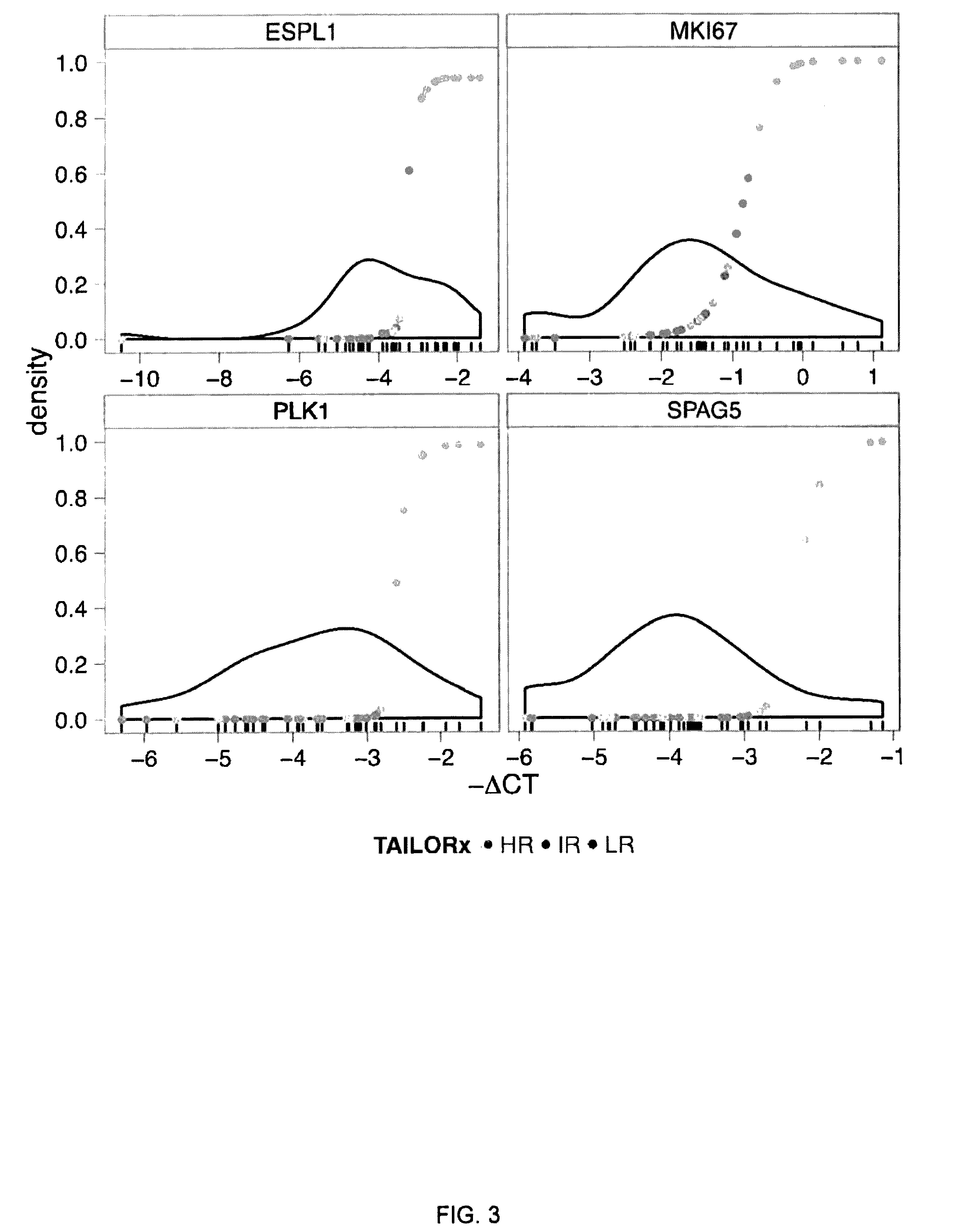Breast cancer prognostication and screening kits and methods of using same
a breast cancer and prognostic test technology, applied in the field of breast cancer molecular genetic tests, can solve the problems of difficult prognostication of breast cancer, and achieve the effect of improving and more accurate screening and prognostic tests and a higher risk of breast cancer relaps
- Summary
- Abstract
- Description
- Claims
- Application Information
AI Technical Summary
Benefits of technology
Problems solved by technology
Method used
Image
Examples
example 1
Materials and Methods, Five Gene Panel Screening Assay / MicroArray Datasets
[0119]The Microarray Datasets Used in this Study
[0120]RNA from primary tumor samples was hybridized to the hgu133a v2 array platform to form the Affymetrix dataset for this study (Table 2). The training set consists of the LN− samples in GSE3494 and GSE7390 (Gene Expression Omnibus, ), with the remainder as the validation set. The CEL files from all series were normalized together and expression values computed with GCRMA [15]. The survival endpoint in this dataset is distant metastasis.
[0121]This study used all ER+, lymph node negative samples in the cohorts listed in Table 2.
TABLE 2Patient characteristics in the microarray datasetsGEO SeriesGSE3494GSE7390GSE12093GSE6532GSE2034GSE11121GSE17705Cohort codeUPPSTRANSBIGVER2OXFDVDXMZMDA# Estrogen202135136144205169289receptor+Lymph node131 / 65 / 6135 / 0 / 0136 / 0 / 0102 / 36 / 6205 / 0 / 0169 / 0 / 0170 / 108 / 0(− / + / NA)Tamoxifen61 / 141 / 00 / 135 / 0136 / 0 / 099 / 45 / 00 / 205 / 00 / 169 / 0289 / 0 / 0(yes / no / NA)...
example 2
INDUCT: A Continuous Score Using Expression Values ofESPLI, MK167, SPAG5, PLK1 and PGR
[0141]A set of 11 genes plus the addition of a PGR gene, is examined in the present example (FIG. 7, step A). This set of 12 genes were ESPL1, CDC45L, PLK1, CENPA, MKI67, SPAG5, CDT1, PRG, CXCL9, CDC6, PHLPP1, and PRPF4.
[0142]To validate, a qRT-PCR analysis of these 12 genes were first examined in a training set of 36 ER+ breast cancer FFPE samples with known Oncotype DX RS (Table 3).
TABLE 3Characteristics of the patients in theFFPE datasets used in this studyFFPE training setFFPE validation setNumber3636Age (15 / 2115 / 21Grade (1 / 2 / 3)8 / 21 / 73 / 24 / 9Size (≦2 cm / >2 cm)24 / 1229 / 7 TAILORx risk groups4 / 18 / 146 / 15 / 15(LR / IR / HR)Oncotype Dx risk groups9 / 16 / 119 / 15 / 12(LR / IR / HR)
[0143]For each of the 12 target genes on the qRT-PCR Array, a mixture model was fit to the distribution of Δ-CT values on the training set of 36 samples (FIG. 7, step B). Risk scores derived from the mixture models (Methods) were plotted agai...
example 3
INDUCT is Translated to the Illumina Array Platform and a Threshold Between Low and High Risk Groups is Selected
[0147]The INDUCT score was translated to the llumina illuminaHumanv3 array platform using the Metabric training data (Table 3).
TABLE 3Characteristics of the patients in themicroarray datasets used in this studyAffymetrixMetabrictraining*validation†trainingvalidationnumber26610032071147lymph node (− / +)266 / 0 782 / 221200 / 7603 / 544Tamoxifen (yes / no)15 / 251568 / 435 0 / 207954 / 193grade (1 / 2 / 3 / NA)80 / 141 / 36 / 100 / 28 / 133 / 129 / 523 / 43 / 237 / 83046 / 0427 / 68size (≦2 cm / >2162 / 102 / 091 / 116 / 796138 / 69 / 0492 / 642 / 13cm / NA)Age110 / 156 / 034 / 173 / 79660 / 147 / 0121 / 1026 / 0(LN-, Tamoxifen-15 (3)369 (45)0422 (38)treated (events)*GSE3494, GSE7390†GSE12093, GSE6532 (Oxford cohort), GSE2034, GSE11121, GSE17705
[0148]Probes representing the 5 INDUCT genes were selected. If there were multiple probes for a given gene, the probe with maximum variance in the training set was chosen. For each panel gene, Mclust was applied to ...
PUM
| Property | Measurement | Unit |
|---|---|---|
| temperature | aaaaa | aaaaa |
| temperature | aaaaa | aaaaa |
| nucleic acid | aaaaa | aaaaa |
Abstract
Description
Claims
Application Information
 Login to View More
Login to View More - R&D
- Intellectual Property
- Life Sciences
- Materials
- Tech Scout
- Unparalleled Data Quality
- Higher Quality Content
- 60% Fewer Hallucinations
Browse by: Latest US Patents, China's latest patents, Technical Efficacy Thesaurus, Application Domain, Technology Topic, Popular Technical Reports.
© 2025 PatSnap. All rights reserved.Legal|Privacy policy|Modern Slavery Act Transparency Statement|Sitemap|About US| Contact US: help@patsnap.com



